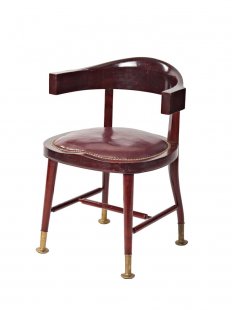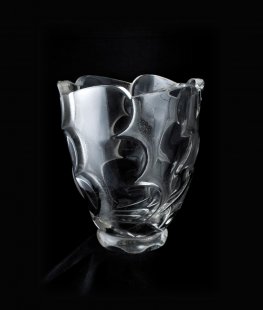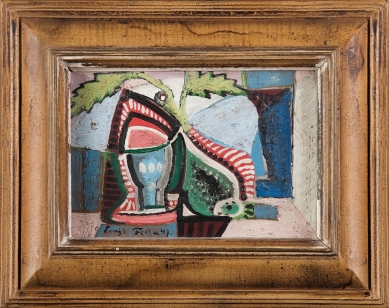
26th auction of the Sýpka house will offer unique furniture by Adolf Loos
The Auction House Sýpka has prepared a collection of over 500 items for its 26th auction. This collection includes paintings, antiques, design pieces, and collections of Czech artistic glass with a total starting price around 7 million CZK.
The upcoming 26th auction is divided into two separate sections, each with its own catalog – Fine Arts, Antiques, Design, and Czech Artistic Glass.
A great opportunity arises for enthusiasts of applied arts and design, who will have a very unique chance to acquire a chair designed by Adolf Loos and an armchair from an interior designed by Adolf Loos. His furniture designs, of which he produced very few, are among the most sought after in the international auction market. They are only exceptionally found in the Czech environment, and each instance presents a rare opportunity to acquire such an item. The chair with armrests was designed by A. Loos for the dining room interior of Eugene Stössler in 1899 and was manufactured after 1900 by the Vienna company F. O. Schmidt. The reclining armchair comes from the Vienna apartment of Rudolf Krause.
The most interesting item in the fine arts section is the intimate painting by Emil Filla “Still Life with a Goblet” from 1947, which is a masterful example of Filla's late period. The painting belongs to a series of still lifes from the 1940s, in which Filla referenced his pre-war work on the same theme from the 1920s and 1930s, echoing residues of cubist forms. Works from this period utilize a more pronounced, contrasting color palette, and their overall approach is simpler, more succinct, without refined compositional plans. They reflect the painful experience of war, manifesting in a more expressive expression. Currently, this mature stage of Filla's work is newly – significantly positively evaluated within the entire oeuvre of the artist.
Emil Filla's works are among the most sought after at Czech auctions and consistently rank among the most in-demand items.
The offer of other sought-after authors is also attractive – prints by František Kupka, the post-war painting “Presence of Man” by Bohumír Matal, the canvas “Places Z” by Vladimír Kokolia, or four newly discovered paintings by Pavel Brázda, along with many others. In addition to modern art, there is also a prominent representation of classical landscape painting from the Mařák School, which is currently highly sought after. Classic portrait painting is represented by two large paintings by Antonín Machka.
In the offer of applied arts and design, exceptional cubist objects and functionalist chrome furniture, which is very much in demand today, will also be presented. Furthermore, high-quality author designs in the areas of glass, metal, and porcelain, mainly from the Czech and Central European environment, will be offered. The furniture is represented by leading firms and authors (UP Závody, Jindřich Halabala, Karel Honzík, Jaroslav Grunt).
The separate offering of Czech artistic glass comprises 124 items, originating from a private collection. This collection is arranged chronologically this time, which provides a good overview of the artistic development of glass and its technological processes. The author of the collection has significantly mapped post-war glass production in our country.
Pre-auction Exhibition
in Brno at Gallery Sýpka, Poštovská 4
February 6 – 10, 2011, from 9:00 AM to 5:00 PM.
February 11, 2011, from 9:00 AM to 4:00 PM.
in Prague at Gallery at the Bethlehem Chapel
February 13 – 18, 2011, from 10:00 AM to 6:00 PM.
February 19, 2011, from 10:00 AM to 4:00 PM.
Auction Title: Fine Arts, Antiques, Design, and Glass
Auctioneer: Auction House Sýpka, s.r.o.
Date: Sunday, February 20, 2011, at 1:30 PM.
Location: Žofín Palace – Prague 1, Slovanský Island 226
Collection of Post-War Czech Glass Design III
Thanks to the Auction House Sýpka, we once again have the opportunity to glimpse into an extensive collection of Czech glass design and even the opportunity to purchase something (or even everything!) from it.
Once again, the auction catalog guides us through the history of glass production over the last few decades. The collection is impressive: it includes many well-known glassworks, numerous famous artists, and countless technologies.
To this day, the range of shapes and colors of glass that artists, in collaboration with skilled craftsmen, have been able to achieve is astonishing. It is not only the number of realized designs, their broad artistic and technological scope, but especially the precise craftsmanship, perfect raw materials, and original artistic conception that characterize Czech glass, which is an internationally known phenomenon. The auction offers a predominance of exclusively crafted decorative items, but more common series production and unique studio works can also be found.
We often do not encounter such a concentrated collection that has been built with so much thought given to the various facets of post-war glass production. However, there was indeed much to choose from, as the modern history of Czech glass design offers innumerable patterns. Only a collector with a good overview of glass production who knows where to acquire the items, but primarily possesses an understanding of the beauty of the material, can compile such a quality collection from such a wide range, as has been presented over the course of these three auctions.
I wish the auction success and the new owners of glass works much joy from the items, many of which are permanently inscribed into the glorious history of Czech glassmaking.
The upcoming 26th auction is divided into two separate sections, each with its own catalog – Fine Arts, Antiques, Design, and Czech Artistic Glass.
A great opportunity arises for enthusiasts of applied arts and design, who will have a very unique chance to acquire a chair designed by Adolf Loos and an armchair from an interior designed by Adolf Loos. His furniture designs, of which he produced very few, are among the most sought after in the international auction market. They are only exceptionally found in the Czech environment, and each instance presents a rare opportunity to acquire such an item. The chair with armrests was designed by A. Loos for the dining room interior of Eugene Stössler in 1899 and was manufactured after 1900 by the Vienna company F. O. Schmidt. The reclining armchair comes from the Vienna apartment of Rudolf Krause.
The most interesting item in the fine arts section is the intimate painting by Emil Filla “Still Life with a Goblet” from 1947, which is a masterful example of Filla's late period. The painting belongs to a series of still lifes from the 1940s, in which Filla referenced his pre-war work on the same theme from the 1920s and 1930s, echoing residues of cubist forms. Works from this period utilize a more pronounced, contrasting color palette, and their overall approach is simpler, more succinct, without refined compositional plans. They reflect the painful experience of war, manifesting in a more expressive expression. Currently, this mature stage of Filla's work is newly – significantly positively evaluated within the entire oeuvre of the artist.
Emil Filla's works are among the most sought after at Czech auctions and consistently rank among the most in-demand items.
The offer of other sought-after authors is also attractive – prints by František Kupka, the post-war painting “Presence of Man” by Bohumír Matal, the canvas “Places Z” by Vladimír Kokolia, or four newly discovered paintings by Pavel Brázda, along with many others. In addition to modern art, there is also a prominent representation of classical landscape painting from the Mařák School, which is currently highly sought after. Classic portrait painting is represented by two large paintings by Antonín Machka.
In the offer of applied arts and design, exceptional cubist objects and functionalist chrome furniture, which is very much in demand today, will also be presented. Furthermore, high-quality author designs in the areas of glass, metal, and porcelain, mainly from the Czech and Central European environment, will be offered. The furniture is represented by leading firms and authors (UP Závody, Jindřich Halabala, Karel Honzík, Jaroslav Grunt).
The separate offering of Czech artistic glass comprises 124 items, originating from a private collection. This collection is arranged chronologically this time, which provides a good overview of the artistic development of glass and its technological processes. The author of the collection has significantly mapped post-war glass production in our country.
Pre-auction Exhibition
in Brno at Gallery Sýpka, Poštovská 4
February 6 – 10, 2011, from 9:00 AM to 5:00 PM.
February 11, 2011, from 9:00 AM to 4:00 PM.
in Prague at Gallery at the Bethlehem Chapel
February 13 – 18, 2011, from 10:00 AM to 6:00 PM.
February 19, 2011, from 10:00 AM to 4:00 PM.
Auction Title: Fine Arts, Antiques, Design, and Glass
Auctioneer: Auction House Sýpka, s.r.o.
Date: Sunday, February 20, 2011, at 1:30 PM.
Location: Žofín Palace – Prague 1, Slovanský Island 226
Collection of Post-War Czech Glass Design III
Thanks to the Auction House Sýpka, we once again have the opportunity to glimpse into an extensive collection of Czech glass design and even the opportunity to purchase something (or even everything!) from it.
Once again, the auction catalog guides us through the history of glass production over the last few decades. The collection is impressive: it includes many well-known glassworks, numerous famous artists, and countless technologies.
To this day, the range of shapes and colors of glass that artists, in collaboration with skilled craftsmen, have been able to achieve is astonishing. It is not only the number of realized designs, their broad artistic and technological scope, but especially the precise craftsmanship, perfect raw materials, and original artistic conception that characterize Czech glass, which is an internationally known phenomenon. The auction offers a predominance of exclusively crafted decorative items, but more common series production and unique studio works can also be found.
We often do not encounter such a concentrated collection that has been built with so much thought given to the various facets of post-war glass production. However, there was indeed much to choose from, as the modern history of Czech glass design offers innumerable patterns. Only a collector with a good overview of glass production who knows where to acquire the items, but primarily possesses an understanding of the beauty of the material, can compile such a quality collection from such a wide range, as has been presented over the course of these three auctions.
I wish the auction success and the new owners of glass works much joy from the items, many of which are permanently inscribed into the glorious history of Czech glassmaking.
Mgr. Milan Hlaveš, Ph.D., Museum of Applied Arts in Prague
Adolf Loos Designs Again on Offer at Auction House Sýpka
Auction House Sýpka will present unique furniture by the significant artist and architect Adolf Loos at its 26th auction. The auction offer follows the offer of the previous 24th auction (May 30, 2010), where extraordinary furniture pieces for the Puschnitz villa, the apartment of Dr. Hirsche in Plzeň, and a lamp for the Müller villa interior in Prague were auctioned.
At the upcoming 26th auction, which will take place on February 20, 2011, at the Žofín Palace, a chair with armrests (item 207) designed by A. Loos after 1900 and realized by the Vienna company F.O. Schmidt in polished walnut wood with brass tips on its legs and a padded seat covered with leather and secured by brass tacks will be offered. The second unique piece is a reclining armchair with upholstered cushions. This armchair comes from the Vienna apartment of Rudolf Krause, whose interior was designed by Adolf Loos in 1907. The armchair is made of dark-stained wood, with a reclining backrest featuring a metal stop. The loose cushions for the seat and backrest retain their original upholstery and cushioning, produced by a successor of Viktor Tepser.
A. Loos (1870 – 1933) was a native of Brno, an exceptionally significant architect and theorist who worked in Vienna and Czech lands. His work is characterized by a rational approach with an absence of decor and ornament. He advocated for functional forms and the inherent beauty of the materials used. His significant buildings – the department store Goldman & Salatch in Vienna from 1910 and the Müller villa in Prague from the years 1928 – 1930 – were precursors to the era of functionalism in all of Europe.
The visionary approach of A. Loos's work is increasingly appreciated today, as his thinking and work are very close to the approaches of postmodern artists. Adolf Loos designed all individual elements of interiors, but he liked to use proven types of furniture pieces from various styles (such as Egyptian seats or tripods), which he shaped and materialized. Only occasionally did he add solitary pieces of his own design.
The main criterion of his work was to acknowledge the character and properties of the materials used and the effort to harmonize the form and function of each space.
Adolf Loos Designs Again on Offer at Auction House Sýpka
Auction House Sýpka will present unique furniture by the significant artist and architect Adolf Loos at its 26th auction. The auction offer follows the offer of the previous 24th auction (May 30, 2010), where extraordinary furniture pieces for the Puschnitz villa, the apartment of Dr. Hirsche in Plzeň, and a lamp for the Müller villa interior in Prague were auctioned.
At the upcoming 26th auction, which will take place on February 20, 2011, at the Žofín Palace, a chair with armrests (item 207) designed by A. Loos after 1900 and realized by the Vienna company F.O. Schmidt in polished walnut wood with brass tips on its legs and a padded seat covered with leather and secured by brass tacks will be offered. The second unique piece is a reclining armchair with upholstered cushions. This armchair comes from the Vienna apartment of Rudolf Krause, whose interior was designed by Adolf Loos in 1907. The armchair is made of dark-stained wood, with a reclining backrest featuring a metal stop. The loose cushions for the seat and backrest retain their original upholstery and cushioning, produced by a successor of Viktor Tepser.
A. Loos (1870 – 1933) was a native of Brno, an exceptionally significant architect and theorist who worked in Vienna and Czech lands. His work is characterized by a rational approach with an absence of decor and ornament. He advocated for functional forms and the inherent beauty of the materials used. His significant buildings – the department store Goldman & Salatch in Vienna from 1910 and the Müller villa in Prague from the years 1928 – 1930 – were precursors to the era of functionalism in all of Europe.
The visionary approach of A. Loos's work is increasingly appreciated today, as his thinking and work are very close to the approaches of postmodern artists. Adolf Loos designed all individual elements of interiors, but he liked to use proven types of furniture pieces from various styles (such as Egyptian seats or tripods), which he shaped and materialized. Only occasionally did he add solitary pieces of his own design.
The main criterion of his work was to acknowledge the character and properties of the materials used and the effort to harmonize the form and function of each space.
The English translation is powered by AI tool. Switch to Czech to view the original text source.



0 comments
add comment












